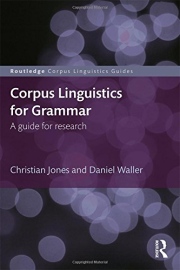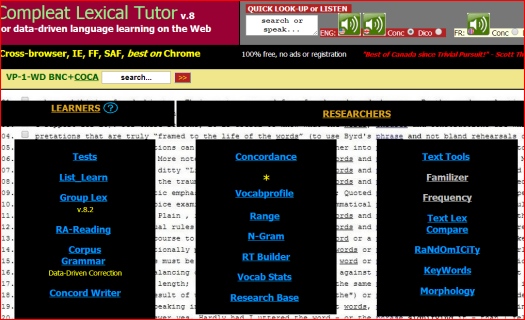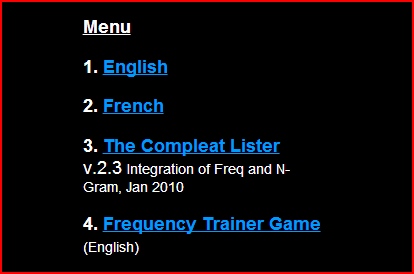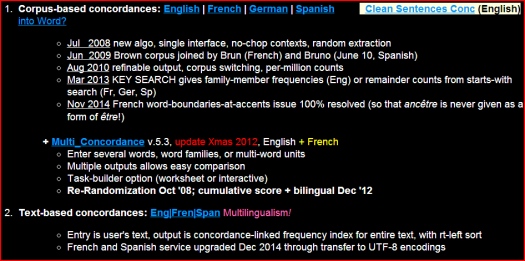Using a Pedagogic Corpus to Develop Language Awareness
Using a Pedagogic Corpus to Develop Language Awareness
Christian Jones is Senior Lecturer in TESOL at the University of Central Lancashire and has previously worked as a teacher and teacher trainer in Japan and Thailand. His main research interests are in spoken language, corpus-informed language teaching and lexis. E-mail: cjones3@uclan.ac.uk
Daniel Waller is Senior Lecturer in EFL and Testing at the University of Central Lancashire and has previously worked as a curriculum designer and teacher in Turkey. His areas of interest are language testing, written discourse, and the teaching of writing for academic purposes.
Their latest publication is Jones, C and Waller, D. (2015). Corpus linguistics for grammar: A guide for research. Routledge.

Menu
Introduction
Classroom idea 1
Classroom idea 2
Exercise
References
In most classes, students read and listen to a lot of texts from their course books and external sources. These texts are often used for comprehension work but can also be used to form a ‘pedagogic corpus’ (Willis 2003) and exploited to develop awareness of the language patterns they contain. This short article gives two examples of how this can be achieved.
One useful source of reading and listening texts which is often neglected in exercises using corpora are those found in the coursebook. Willis (2003) suggests that rather than simply using reading and listening material for comprehension these texts can form what he terms a ‘pedagogic corpus’ and a number of patterns can be focused upon, analysed, and discussed. The key part of such work is that the texts have already been processed for meaning and understood by learners. Once this has happened, the teacher needs to return to texts which have been used for comprehension work in order to look for useful language patterns.
The example below is taken from Jones and Waller (2011) and gives a sample task, where the focus is on observation of conditional patterns, All the examples used in the are taken from the tapescripts of Natural English Intermediate (Gairns and Redman 2002)
Look at the following examples of conditionals, which do not always contain an ‘if’ clause. Each example is taken from a listening text we have already studied (tapescript numbers are given after every sentence). For each example, decide whether the speaker is describing something:
- Real—which actually happens, which actually happened, or will happen or,
- Unreal—which did not actually happen, does not happen, or is not likely to happen.
Then decide if each example refers to c) the present, d) the past, or e) the future.
Example:
If I’m feeling tired, I try my best to get an early night. (a, c.)
- … it’s a great way to see the city
Would you go again? (2.3)
Definitely.
- … apparently hypnosis can work, if you apply yourself to it, I quite like that idea. (4.5)
- Well, if we aim for about an hour’s talk and then there’s some time for question and answers afterwards. (4.8)
- Make sure it’s correct, because, you know, it costs me money if you make a mistake. (5.7)
- Erm, if you have a problem at work with somebody in the family, it affects your work. (6.3)
- Well, if you have school qualifications and basic computer skills, you should be fine. (6.5)
- Listen, if it works out, come and visit? (8.4)
- If I had more time, like on holiday, for example, I’d have a very long, slow, lazy lunch. (9.2)
- If I have to buy a present for someone, I really like to take my time. (9.2)
- If I had a cleaner, things’d be different and the place might just get tidy quicker. (9.2)
This kind of activity is aimed at building learners’ language awareness, helping them to notice some patterns in the input they have been exposed to and already processed for meaning. The rationale behind such activities is that the more learners develop this awareness, the better able they will be to make clear choices when they choose to use these particular forms. It is also hoped that this type of activity encourages learners to notice language for themselves within textbook reading and listening work.
Other texts which students read can also form part of a pedagogic corpus. Recently, several authors have made the case for the benefits of ‘narrow reading’ (for example, Schmitt and Carter 2000; Krashen 2004), that is, encouraging learners to read several texts on a similar topic, rather than one text on each of a range of topics. The argument for this is that this will expose learners to similar types of language each time they read and in doing so will help texts to become more comprehensible. It is also more likely that some of the language they meet will be acquired if they meet it several times. Providing the texts are available online, it is fairly straightforward to compile a corpus of such texts and use free corpus analysis tools to exploit these for language work. The first step is to choose texts which learners are interested in and which have been processed for meaning. The texts needs to be on the same topic and from a similar genre. In this example, we have chosen to look at factual texts about Preston, as many of our learners wish to find out something about the city in which they are studying. Following this, the teacher can use the texts as a small corpus and feed these into LexTutor (www.lextutor.ca). We can then produce lists of the most frequent words and keywords (those which occur with much greater frequency in our chosen texts than in comparison with a general reference corpus) and concordance lines containing these words.
The process can be summarised as follows
- Choose texts which have been used for ‘narrow reading’ in all texts of a similar genre on the same topic.. In this case we chose texts from the websites below:
www.visitlancashire.com/explore/preston
http://en.wikipedia.org/wiki/Preston,_Lancashire
www.uclan.ac.uk/visit/about_preston.php
- These can then be pasted into LexTutor or (if longer) saved as plain text file and uploaded as documents. Go to LexTutor and Upload the texts into the ‘frequency’ tab here:

- Once in the frequency tab, click on ‘English’

- Upload the texts and ‘submit’ to produce a frequency list.
In this case, we produced the following words as the ten most frequent

- We can then repeat this process by clicking on ‘keywords’. The general reference copus is the default, which mixes the British National Corpus and Corpus of Contemporary American English as a reference. The output produced was a s follows in this case:
The number preceding each word in the output below is the number of times more frequent this word is in your text than it is in the reference corpus proportionally. For example, the first item in the output 2849.00 guild means that guild has 26 natural occurrences in 14,000,000 words, but 4 occurrences in your 756-word text. This would work out to (4/756) x 14,000,000 = 74,074 occurrences if your text were the same size as the corpus. The word is thus 74,074 / 26 = 2849.00 times more frequent in your text than it is in the reference corpus. This probably means the word plays an important (or 'key') role in your text.
(1) 2849.00 guild
(2) 2525.27 textile
(3) 108.61 district
(4) 104.31 city
(5) 96.96 proud
(6) 95.13 mill
(7) 69.19 plenty
(8) 59.64 north
(9) 58.37 century
(10) 54.15 population
These two lists (frequency and keywords) suggest that one item we may want to draw learners’ attention to in these texts is ‘city’.
- We can then click on ‘concordance’ input our texts can then be used for a classroom activity, as in the sample exercise. . To do this we need to click on number two ’text based concordance Eng’ and upload our texts.

- This then produces concordance lines for the words ‘city’. These can then be used for an exercise such as the one below. In this case, we have edited the concordances to make them accessible to students.
Look at the word ‘city’ in the sentences below, taken from the texts you have read about Preston. Which adjectives are used before this word? Which nouns are used after it? Are they positive, negative or neutral?
- There are 30,000 students living in Preston, which makes the CITY a lively, diverse and contemporary place to study.
- From there you can also head off around the Guild Wheel too, in a CITY boasting more than 160 miles of footpaths and bridleways.
- through Avenham and Miller Parks and Winckley Square to get a taste of the CITY centre’s green spaces, wildlife habitats and play areas.
- the Harris Museum’s monument to ‘Literature, Arts and Science’, one of six CITY museums. There’s much to marvel at the docks and marina as well,
- Preston has a population of 114,300, the whole CITY of Preston district has a population of 132,0002 and the Preston built
- The whole district obtained CITY status in 2002, becoming England's 50th CITY in the 50th year of Queen
- the North West of England, Preston is a vibrant, cultural and friendly CITY with plenty of landmarks, activities and events to keep you occupied
- a lively, diverse and contemporary place to study. Preston is a mid sized CITY, located a short distance from the coastline, the Lake District nation
- once every 20 years, there’s always something going on in this proud CITY. A variety of events take place throughout the seasons
The texts we have read are factual pieces of writing. How would you say the examples below if describing Preston to a friend?
- There are 30,000 students living in Preston, which makes the CITY a lively, diverse and contemporary place to study.
- From there you can also head off around the Guild Wheel too, in a CITY boasting more than 160 miles of footpaths and bridleways.
Talk to a partner and complete these sentences so that they are true for you:
- My impression so far is that Preston is a/an… CITY
- I think London/Shanghai/ etc…. is a/an…. city.
- If I were to compare Preston to…. I would say it’s ….
The purpose of this activity is primarily the same as in teaching activity one. The intention is to build learners’ language awareness, helping them to notice some patterns in the input they have been exposed to and already processed for meaning.
Compleat Lexical Tutor (2015). Available from: www.lextutor.ca
Gairns, R. and Redman, S (2002). Natural English Intermediate Student's Book and Listening
Booklet. Oxford: Oxford University Press.
Jones, C and Waller, D (2011). If only it were true: the problem with the four conditionals. ELT Journal 65(1), pp. 24–32.
Krashen, S. (2004) The case for narrow reading. Language Magazine 3(5), pp. 17–19.
Schmitt, N and Carter, R. (2000).The lexical advantages of narrow reading for second language
learners. TESOL Journal 9(1),pp. 4–9.
Willis, D. (2003). Rules, Patterns and Words: Grammar and Lexis in English Language Teaching. Cambridge: Cambridge University Press.

Please check the English Language Improvement for Teachers course at Pilgrims website.
Please check the Creative Methodology for the Classroom course at Pilgrims website.
Please check the Methodology for Teaching English Spoken Grammar course at Pilgrims website.
Please check the Methodology for Teaching English Spoken Grammar course at Pilgrims website.


|